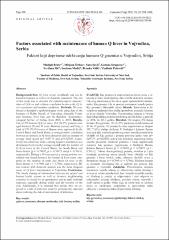| dc.description.abstract | Background/Aim. Q fever occurs worldwide and can be
found in humans as well as in domestic mammals. The aim
of this study was to describe the epidemiological characteristics of Q fever and evaluate correlation between the Q fever occurrence and weather conditions. Methods. We conducted a descriptive epidemiological study using data of the
Institute of Public Health of Vojvodina, Scientific Veterinary Institute, Novi Sad, and the Republic Hydrometeorological Service of Serbia, from 2006 to 2015. Results.
Out of 272 human Q fever cases, 114 (41.9%) patients were
aged between 20 and 39 years. Between January and May, a
total of 193 (71.0%) cases of disease were registered. In the
Central Banat and South Banat, a strong positive correlation
between an increase in Q fever detection and an increase of
average wind speed (ρ= 0.69719 and ρ=0.62303, respectively) was observed, while a strong negative correlation was
determined between the average rainfall with the number of
Q fever cases in the Central Banat, the South Banat and
Srem district (ρ = -0.78033, ρ = -0.70675 and ρ = -0.70431,
respectively). During a 10-year period, a strong positive correlation was found between the human Q fever cases compared to the number of cattle and sheep Q cases in the
Srem district (r = 0.7989 and r = 0.7966, respectively). Direct contact with domestic animals was the most frequent
route of Q fever transmission in Vojvodina. Conclusion.
The timely sharing of information between the animal and
human health sectors as well as between neighbouring
countries is crucial for an appropriate and an early outbreak
response, especially during windy and dry months of the
year. Additionally, it is essential that people who are exposed to a risk of infection must be permanently educated
about reducing the risk of transmission of infection. | en_US |

